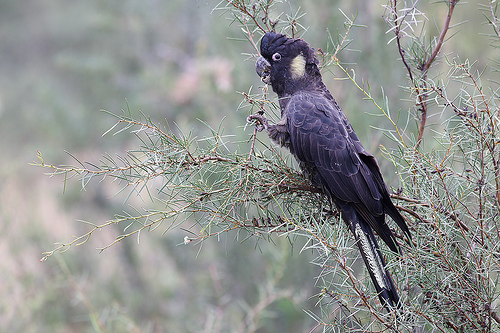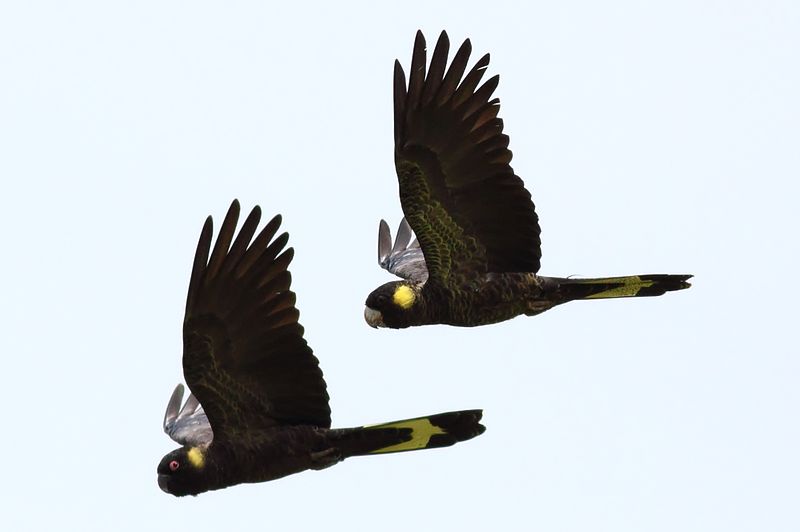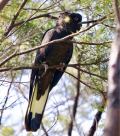Colours
Distinguishing features
It has a short mobile crest on the top of its head, and the plumage is mostly brownish-black with paler feather-margins in the neck, nape, and wings, and pale yellow bands in the tail feathers. The tails of birds of subspecies funereus measure around 33 cm.
The plumage is a more solid brown-black in the eastern subspecies, while the southern race has more pronounced yellow scalloping on the underparts.
The male Yellow-tailed Black Cockatoo has a black bill, a dull yellow patch behind each eye, and pinkish or reddish eye-rings. The female has grey eye-rings, a horn-coloured bill, and brighter and more clearly defined yellow cheek-patches. Immature birds have duller plumage overall, a horn-coloured bill, and grey eye-rings. The upper beak of the immature male darkens to black by two years of age, commencing at the base of the bill and spreading over ten weeks. The lower beak blackens by four years of age.
The elongated bill has a pointed maxilla (upper beak), suited to digging out grubs from tree branches and trunks.
Records of the timing of the eye ring changing from grey to pink in male birds are sparse, but have been recorded anywhere from one to four years of age.
The Yellow-tailed Black Cockatoo is distinguished from other dark-plumaged birds by its yellow tail and ear markings, and by its contact call. (Wikipedia)
Size
- From 55 cm to 65 cm (Length of specimen)
Wingspan
- Up to 110 cm
Synonyms
Distribution
Distribution and habitat preferences
The birds may be found in a variety of habitats including grassy woodland, riparian forest, heathland, subalpine areas, pine plantations, and occasionally in urban areas, as long as there is a plentiful food supply. They have also spread to parts of suburban Sydney, particularly on or near golf courses, pine plantations and parks. (Wikipedia)
Diet
The diet of the Yellow-tailed Black Cockatoo is varied and available from a range of habitats within its distribution, which reduces their vulnerability to degradation or change in habitat. Much of the diet comprises seeds of native trees, particularly she-oaks (Allocasuarina and Casuarina, including A. torulosa and A. verticillata), but also Eucalyptus (including E. maculata flowers and E. nitida seeds), Acacia (including gum exudate and galls), Banksia (including the green seed pods and seeds of B. serrata, B. integrifolia, and B. marginata), and Hakea species (including H. gibbosa, H. rugosa, H. nodosa, H. sericea, H. cycloptera, and H. dactyloides). They are also partial to pine cones in plantations of the introduced Pinus radiata and to other introduced trees, including Cupressus torulosa, Betula pendula and the buds of elm Ulmus species. In the Eyre Peninsula, the Yellow-tailed Black Cockatoo has become dependent on the introduced Aleppo pine (Pinus halepensis), alongside native species.
The Yellow-tailed Black Cockatoo is very fond of the larvae of tree-boring beetles, such as the longhorn beetle Tryphocaria acanthocera, and cossid moth Xyleutes boisduvali. Birds seek them out all year but especially in June and July, when the moth caterpillars are largest, and they are accompanied by their just fledged young. They search out holes and make some exploratory bites looking for larvae. If successful, they peel and tear down a strip of bark to make a perch for themselves before continuing to gouge and excavate the larvae, which have deeply tunneled into the heartwood.
They drink at various places, from stock troughs to puddles, and do so in the early morning or late in the afternoon. Insect larvae and Fabaceae seeds are among food reported to have been fed to young. (Wikipedia)





